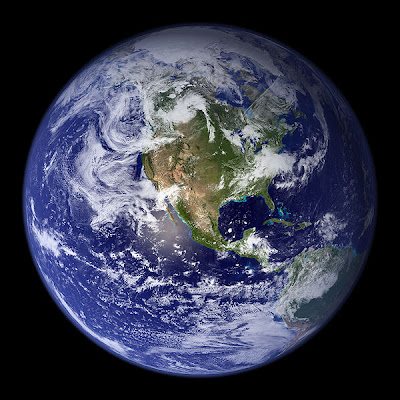Earth / La Tierra

The Earth is the third planet in proximity to the Sun and it is the densest and fifth-largest of the planets in the Solar System. It is a rocky planet and the only hitherto known with existence of life as millions of species living in it. The Earth has a thick atmosphere composed by 78% nitrogen, 21% oxygen and 1% molecular argon, plus traces of other gases such as carbon dioxide and water vaporized. The atmosphere lets in sunlight turn trapping terrestrial radiation, producing the greenhouse effect. Thanks to this, the Earth's average temperature is about 17 ° C. The Earth's atmospheric composition is maintained by the biosphere, thanks to the large amount of free oxygen produced by plants through photosynthesis, which by the action of sunlight transforms CO2 into O2. Free oxygen in the atmosphere is the result of the presence of life on earth and not vice versa. The Moon is the only natural satellite of the Earth, with an average distance of 384,400 km. As the size difference between both bodies is minimal, it is often questioned today the relationship of the planet with its satellite, as compared to other satellites in the solar system. The diameter of the earth is 12,742 km and the diameter of the moon is 3,476 km.
__________________
La Tierra es el tercer planeta en cercanía al Sol, es el más denso y el quinto más grande de los planetas del Sistema Solar. Es un planeta rocoso y el único del universo en el que hasta ahora se conoce la existencia de vida; ya que millones de especies habitan en él. La Tierra tiene una espesa atmósfera compuesta en un 78% de nitrógeno, 21% de oxígeno molecular y 1% de argón, más trazas de otros gases como anhídrido carbónico y agua vaporizada. La atmósfera deja entrar la radiación solar atrapando a su vez la radiación terrestre, produciendo el llamado efecto invernadero. Gracias a esto la temperatura media de La Tierra es de unos 17 °C. La composición atmosférica de la Tierra se mantiene por la biosfera, gracias a la gran cantidad de oxígeno libre que producen las plantas a través de la fotosíntesis, que por la acción del sol transforma CO2 en O2. El oxígeno libre en la atmósfera es consecuencia de la presencia de vida en la tierra y no al revés. La Luna es el único satélite natural de la Tierra, con una distancia media de 384.400 km, se cuestiona hoy en día la relación del planeta con su satélite, ya que en comparación al resto de satélites del sistema solar, la diferencia de tamaño es mínima, hablándose incluso de un sistema binario. El diámetro de la tierra es de 12.742 km y el diámetro de la luna es de 3.476 km.
__________________
La Tierra es el tercer planeta en cercanía al Sol, es el más denso y el quinto más grande de los planetas del Sistema Solar. Es un planeta rocoso y el único del universo en el que hasta ahora se conoce la existencia de vida; ya que millones de especies habitan en él. La Tierra tiene una espesa atmósfera compuesta en un 78% de nitrógeno, 21% de oxígeno molecular y 1% de argón, más trazas de otros gases como anhídrido carbónico y agua vaporizada. La atmósfera deja entrar la radiación solar atrapando a su vez la radiación terrestre, produciendo el llamado efecto invernadero. Gracias a esto la temperatura media de La Tierra es de unos 17 °C. La composición atmosférica de la Tierra se mantiene por la biosfera, gracias a la gran cantidad de oxígeno libre que producen las plantas a través de la fotosíntesis, que por la acción del sol transforma CO2 en O2. El oxígeno libre en la atmósfera es consecuencia de la presencia de vida en la tierra y no al revés. La Luna es el único satélite natural de la Tierra, con una distancia media de 384.400 km, se cuestiona hoy en día la relación del planeta con su satélite, ya que en comparación al resto de satélites del sistema solar, la diferencia de tamaño es mínima, hablándose incluso de un sistema binario. El diámetro de la tierra es de 12.742 km y el diámetro de la luna es de 3.476 km.



Comentarios
Publicar un comentario